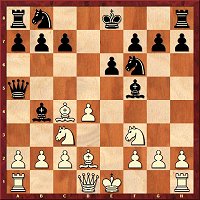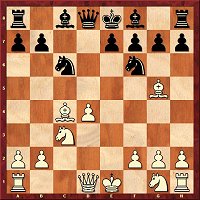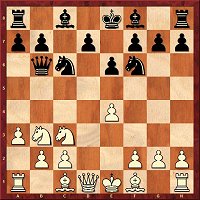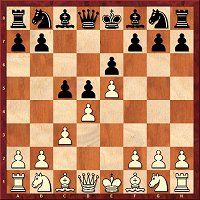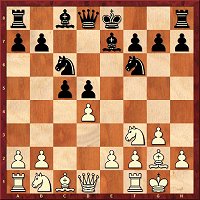|

| Introductory videos
Grandmaster Karsten Müller sets the scene for this new DVD in the tried and tested way with his introductory video with a highlight from each of the top tournaments. For example, he explains Carlsen’s final combination from his second victory over Ivanchuk in the Grand-Slam final and also Polgar’s endgame technique from her dramatic game against Dominguez Perez in the World Cup. From the twelve openings contributions on the DVD Müller has selected Leonid Kritz' article on the French Fort Knox Variation (3...dxe4 4.Nxe4 Bd7 and then ...Bc6 and ...Bxf3), which is interesting from the point of view of White as well as Black, as well as some repertoire recommendations against 1.e4: Krasenkow suggests a fianchetto system (1...g6 and then Bg7, c6, d5 and Qb6), and Marin also advocates an early fianchetto of the king’s bishop in the Three Knights Game. |
 | GM Dorian Rogozenco summarises the tournament highlights of the last two months in his video review. He pays tribute to Peter Svidler’s magnificent victory in the FIDE World Cup, for example, with a demonstration of the latter’s brilliant mating combination in his second game against Kamsky. From what was nominally the strongest tournament of the year - the Grand-Slam final in Sao Paulo and Bilbao – the Romanian presents Ivanchuk’s fantastic victory with Black over Aronian, a game which is analysed in depth on the DVD by GM Krasenkow (see below). |
| 26.09.-11.10.2011 
Carlsen und Ivanchuk
were making the music
| Grand Slam Final Sao Paulo/Bilbao In the Grand-Slam Final only two of the six top players managed to stand out: Vassily Ivanchuk was the man of the moment in the first leg in Sao Paulo, Magnus Carlsen dominated the return leg in Bilbao. Going by the traditional way of scoring in chess, the Norwegian would have won the tournament with 6 out of 10 (ahead of Ivanchuk with 5.5). In view of the course of the tournament it was somehow fitting that both of them tied at the end on 15 points because of the three points for a win rule used in the "Masters". A playoff with blitz thinking time was to decide the outcome of the tournament. In the first tie-break game Carlsen was better with White, but Ivanchuk escaped with a draw. The second game, on the other hand, was a very one-sided affair going in favour of the Norwegian, who was thus able to celebrate a further success in a top tournament. |

Carlsen,M - Ivanchuk,V 1-0
Position before 17.Rxd7
| Magnus Carlsen scored a whole six of his 15 points in his games against Ivanchuk – for some reason the Ukrainian seems to be unable to come to proper terms with his style. On the DVD Carlsen annotates the second game between the two stars. The leader in the world ranking list set about matters very energetically with White and after around 15 moves of a side variation of the Nimzo-Indian he achieved a strong initiative on the kingside. In the position on the board Carlsen was unable to resist the temptation to play the move 17.Rxd7. In analysis, however, he admits had he been somewhat more circumspect he would have played 17.Rd4, followed by Bd2 and Rh4. But in spite of a few more inaccuracies on his part and an unsuspected defensive resource found by the Ukrainian, Carlsen managed to win the game at the end thanks to the weakened black kingside. Click on the link under the diagram and play through the game with the comments of the Grand-Slam victor of 2011! |
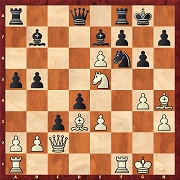
Aronian,L - Ivanchuk,V 0-1
Position before 20.Nxf7
| Perhaps the most impressive example of how Vassily Ivanchuk dominated the tournament in the first leg can be seen in his fourth round game against Levon Aronian. Both sides went for broke in this game, but the Armenian’s 14.g2-g4 saw him become active on the wrong wing according to the analysis of Krasenkow. In fact, instead of that Ivanchuk struck on the queenside with 14...b5 and Black came out of the complications following 16...c5 with the right end of the stick. In the position on the board Aronian decided on the capture 20.Nxf7, but after 20...Qd5 the white position is essentially already lost. Instead of the text move 20.exf7+ Kg8 21.bxc3 dxe3 22.Qh2 would have led to a very complicated but unclear position. |

What went wrong?
Vallejo Pons,F - Ivanchuk,V 1-0
| The game Vallejo-Ivanchuk marked a decisive break in the course of the tournament. After a victory in round 6,the apparently uncatchable tournament leader suffered his second defeat. In the Grünfeld Defence the Spaniard moved forward in the centre and set up in typical fashion for this opening a passed pawn on d6. In the major piece ending, Ivanchuk played too optimistically (e.g. with 22...Qxc3), with the result that the game finally slipped through his fingers. French GM Edouard annotates this and eleven other games from the Grand-Slam final on the DVD. In addition, Iranian GM Moradiabadi has analysed six more games. |
| 25.09.-01.10.2011 
The victorious team from
St Petersburg
| European Cup in Rogaska Slatina If such a thing as a lucky streak exists in chess, then at the moment Peter Svidler is in the middle of one. After his magnificent victory in the Russian individual championship (CBM 144) and winning the FIDE World Cup (see below) he was also successful with his St. Petersburg team in the European Cup. This time, however, it was not his performance which was crucial for the success of the team. Below the top board, it was rather Nikita Vitiugov, Sergei Movsesian and Vadim Zvjaginsev who notched up the decisive points. You will find on the DVD not only over 1200 games from the European Cup, but many of the participants have annotated their own games for this issue of ChessBase Magazine, including Vitiugov, Volokitin, Eljanov, Sutovsky and Bartel. |

Vitiugov,N - Motylev,A 1-0
Position after 19.Nc4
| 24 year old Russian Nikita Vitiugov has annotated on the DVD two strategically first class victories as White which were important for the outcome of the tournament. In the match against Team Tomsk-400 he met Alexander Motylev. Vitiugov did not want to test the latter’s knowledge of the Slav and so he opened with the English with 2.g3, with the prospect of a long game. But for his part Motylev set about things actively and from the opening set up potential threats against the white king. The diagram on the left contains a critical position. Here Black could have played 19...Qh6 bearing in mind the threatened advance g7-g5 and forced the sequence of moves 20.Nxd6 exd6 21.f4 a5 leaving him with a slight advantage. After19...Re8 on the other hand, Vitiugov got the better game with 20.Ne5 Bxe5 21.dxe5 Re6 22.Bc3. However, it was in the time trouble phase that the game was decided. Firstly Vitiugov gave away his advantage with a mistake on move 35 and then in the ending Motylev missed several drawing liquidations and finally resigned three pawns down. |

Volokitin,A - Drabke,L 1-0
Position before 24...Bc8
| Two of their best games have been annotated by Volokitin and Sutovsky of the favoured team SOCAR, which gained the silver medal with a final round victory over Baden-Baden. A day after SOCAR had practically thrown away their chances of tournament victory with their defeat at the hands of Bosna Sarajevo, their stellar ensemble took out their frustration against underdogs SF Reichenstein. In their 5.5:0.5 victory Andrei Volokitin had a sharp attacking win against German IM Lorenz Drabke. However, for a long time Drabke defended long and carefully. He only really clearly fell behind in the position on the board after the over-passive 24...Bc8. Volokitin has analysed the game in depth and at the end of his calculations comes to the conclusion that after 24...Rac8 25.Rcf1 f5 Black is not yet lost, despite how things look at first sight. In the game the moves 25.Rcf1 Nd8 were followed by the strike 26.Nxd5 and after a mistake in time trouble Drabke once more found himself in a mating net of his opponent. |
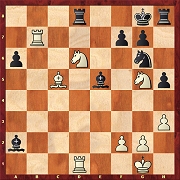
Sutovsky,E - Naiditsch,A 1-0
Position after 27...Rd8
| In the 4:2 victory over the German champions in the final round Emil Sutovsky had a convincing win against Arkadij Naiditsch’s Berlin Defence. The German GM continued according to expectations with 10...h6. Sutovsky, who describes this plan “as a little too slow” in his analysis on the DVD forced things with an early 16.e6. In the position on the board Naiditsch reacted to 27.Ne4-g5 with the natural looking 27...Ra8-d8 – but that loses the game. After the subtle move 28.Rd2 Black must first exchange the bishop on d6, the a-pawn falls, the white-squared bishop becomes the quarry and finally the strike 35.Rxg6 seals Black’s fate. The Israeli GM annotates the game for you on the DVD. |

Pavel Eljanov (Saratov)
This time "only" 4th place
| In the last two years the Russian team Ekonomist Saratov stole the show and won the title in each case undefeated. Pavel Eljanov was also among the top scorers in Rogaska Slatina once more with 5.5 out of 7. Yet this time it was not enough to defend the title. The decisive damper was a close defeat in round 4 at the hands of Tomsk. Nevertheless in the final round Saratov (Tomashevsky, Nepomniachtchi, Eljanov, Moiseenko, Ni Hua, Alekseev) was still in the hunt for medals, but their 3:3 against SHSM-64 was only enough for 4th place. |

Caruana,F - Eljanov,P 0-1
Position after 54.Rb4
| In the final round Pavel Eljanov scored an interesting victory with Black in the Caro-Kann, which the Ukrainian analyses on the DVD. His opponent, Fabiano Caruana, chose what has recently been the modern Advance Variation with 4.Nd2 and 5.Nb3. The Italian went on to exchange his bishop pair for the two black knights, but this did not bring him any advantage. At the same time it turned out that the material which was left was not enough for White to attack the king and after the exchange of queens Black had nothing more to fear. Quite on the contrary, after a few little inaccuracies Eljanov gradually achieved a greater advantage. Can you see the elegant manoeuvre with which Black (to move) brought the game to an end? |

Bartel,M - Predojevic,B 1-0
Position after 14.Nxe2
| With his 6.5 out of 7 Mateusz Bartel of the Novy Bor team was one of the most successful players in the tournament. He annotates two of his wins on the DVD. In Koykka-Bartel he had some luck that his opponent did not find the optimal continuation after the objectively dubious exchange sacrifice 14...Rxf3 and a few moves later ruined with a blunder the game which had been a good one until then. In Bartel-Predojevic the Polish GM was successful in the Two Knights Defence with 4.Ng5 d5 5.exd5 Na5 6.Bb5+ Bd7. According to Bartel’s analysis the critical position in the game was reached after 14.Nxe2 (diagram). His opponent went for the tempting 14...Re5, but after 15.f4 Rxd5 16.Qf3 White not only has a pawn more, but the apparently active black pieces on a5 and d5 are more the hunted than the hunters. In the game Bartel actually went on the attack and brought about the decision with the remarkable sacrifice 29.Bc1-h6. |
28.08.-19.09.11 
Peter Svidler
Laughing victor
| FIDE World Cup Peter Svidler finished the FIDE World Cup in Khanty-Mansiysk 2011 with a clean slate and qualified, as did his final opponent Alexander Grischuk and third placed Vassily Ivanchuk, for the next WCh candidates tournament. On the way to one of his greatest successes of recent years, Svidler, unlike many of his rivals, only had to go into a tiebreak twice (against Nguyen and Caruana) and won convincingly in both cases. On the DVD you will find games analysed by various participants in the tournament, e.g. by Caruana, Polgar, Gashimov and Potkin. |

Svidler,P - Caruana,F 1-0
Position before 29...c5
| Fabiano Caruana annotates his defeat as Black at the hands of Svidler in the first tie-break game. After two classical games in which not much had happened, the Italian was quite content with the way the opening had gone (a Slav with 4...Bg4 5.Qb3). And after a mistake by Svidler (22.f4) he actually had the better game and required him to give up a pawn for an ending with some initiative. The position on the left shows the critical position at which the whole game started to turn round. Caruana chose 29...c5 and argues that the match and with it the whole tournament might possibly had gone differently if he had chosen 29...Nd5 30.Kf2 Rd3. Instead of that, in the game he followed up with a series of inaccuracies which culminated in the shutting in of his own rook. In the second tie-break game Caruana once more had chances (32.Bxe5), but he finally lost a piece in the ending and also lost this game. |

Judit Polgar
annotates
| Once more since her comeback Judit Polgar attracted a lot of attention. A brilliant third place in the European championship in the spring had brought her qualification for the World Cup. And here too she was looking good. Amongst others she eliminated Sergei Movsesian and the player with the strongest Elo in the tournament, Sergej Karjakin, and on occasion demonstrated steady nerves and enormous will-power. However, like Caruana she went down before the outstanding Svidler. |

Dominguez Perez,L - Polgar,J 0-1
Position before 18.Bxf5
| At the start of the analysis of her second game against Leinier Dominguez-Perez Judit Polgar goes into her previous experiences in tournaments in Khanty-Mansiysk. In fact this World Cup was her third tournament in this chess mecca in Siberia. Before this game the omens were unfavourable to the Hungarian player. She had lost the first game with White, and now she needed a victory with Black. In the hope of a fighting game Polgar turned to 4...Qb6 in the Sicilian. Dominguez accepted the challenge and first sacrificed a bishop and four moves later the other one. However, the result was neither a mate nor a perpetual check, but a really complicated endgame in which Polgar gradually gained the upper hand and finally reached a winning position. But she did not find the path to the win and became so nervous that she missed a threefold repetition of the position. A draw? No. Dominguez missed this detail which cost him the game and after his defeat in the subsequent tie-break his passage into the next round. Click on the link under the diagram and play through this high level roller coaster of a game with the extensive comments of Judit Polgar. |

Shirov,A - Potkin,V 0-1
Position before 32...0-0
| The reigning European champion, Vladimir Potkin, was taking part in the World Cup for the first time. In the form of Shirov and Vitiugov he put two 2700 rated players out of the running, before drawing the short straw against the future finalist Grischuk. On the DVD he comments for you on his French victory over Shirov. The naturalised Spaniard had lost the first game and was trying to stir up trouble with the help of some unconventional opening moves (10.g3 and 12.Bh3). That only worked to a certain extent. After Potkin’s 17...Qc2+ the game went into an ending in which White had first one and then two pawns for the exchange. But in return Potkin obtained activity. In the position on the board his 32nd move castling set the trap into which Shirov would fall in his time trouble. Can you see with which trick 33.e6 will be punished? |

Vugar Gashimov
| Vugar Gashimov made it to the quarter-final with for example vicstories over Azarov, Tomashevsky and Heine Nielsen. On the DVD he annotates a win against Azarov and a defeat at the hands of Ponomariov, which marked the end of the tournament for the Azeri.In Gashimov-Ponomariov, as he explains in his analysis, he used up much too much time in the opening phase (a Berlin Defence). And in the ending with rook + bishop against rook + knight, he missed his way to a draw and was finally defeated in a technically demanding ending with bishop versus knight, which Karsten Müller explains in a video analysis in his endgame column. |

Gashimov,V - Azarov,S 1-0
Position before 19.Qa3
| His game with White against Sergei Azarov in the second round followed a more energetic and successful course. Gashimov met the latter’s Schliemann Gambit with 4.d3 fxe4 5.dxe4 Nf6 and then with the as yet rarely played 6.Be3. After castling long and some prophylaxis on the queenside, he set about the Bielorussian’s king position with an advanced h-pawn and a knight sacrifice on g6. In the position on the board Gashimov demonstrated the breadth of his vision with the wonderful quiet move 19.Qa3. There is already a hint of the classical motif: doubling of the rooks on the h-file, double rook sacrifice (on g8 and h8), check with the queen on h3 and subsequent mate. But things did not go as far as that. Azarov soon resigned after a few intermediate moves. |

Karjakin,S - Laznicka,V 1-0
Position after 12...Nxb4
| Sergei Karjakin annotates Together with Etienne Bacrot, Sergei Karjakin won the 12th Karpov Tournament in Poikovsky in Russia in October. This tournament was once more a very strong one (category 19) and the number of draws was noticeably high (around the 80%), and therefore at the end the two victors only needed a score of +2. Karjakin annotates on the DVD his victory over Viktor Laznicka. The Czech GM chose a sharp line of the Caro-Kann Advance Variation and was unlucky enough to come up against a well-prepared opponent. Karjakin had already analysed the previous game which saw his opponent’s 11...Bb4 and decided that the text move was a "big mistake". After 12.Rxb4 Nxb4 (diagram) he followed up with the innovation 13.Bd1, and Black was already on the edge of the abyss. Laznicka at first found the best replies, but then one mistake (18...Be2) was sufficient to give away the game completely. Play through the game with the comments of the top grandmaster and enjoy an encounter full of tactics.
|
| 
What should White play here?
You will find the solution in Oliver Reeh's Tactics column
| From the opening trap to the endgame study Training in ChessBase Magazine starts with the very first moves and takes in all the phases of a game of chess. The 12 up-to-date Opening articles with their numerous ideas and suggestions for your repertoire can be found above among the links. This time Rainer Knaak’s Opening Trap (including its Fritztrainer video) contains a trap in the Pirc Defence (B06). You will also find in video format the openings articles by Leonid Kritz (French Winawer Variation), Valeri Lilov (Colle System) and Dejan Bojkov (Queen’s Gambit Accepted). These videos can be found under the heading Fritztrainer. Peter Wells’ subject in his Strategy column is called: "Capturing towards the centre?" In Daniel King’s long running favourite Move by Moveit is a game with the Philidor Defence which is up for discussion. And in the Tactics (subject: queens in danger) and Endgame(subject: tricks in rook endings) columns, Oliver Reeh and Karsten Müller have once more collected for you the best from recent tournament practice.
|



























